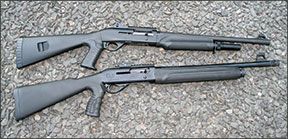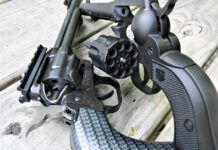The shotgun is the consummate defense weapon, having the ability to load up or down, depending on the situation: down for close-range work with buckshot, up for longer range with slugs. Shotguns can also be loaded with less lethal loads – polymer or rubber shot-that can incapacitate an intruder or get the attention of a black bear raiding the bird feeder in the spring. The Benelli M2 Tactical and the EAA SAR Semi-Auto Special Purpose (SARSASP) are specifically designed for defensive and tactical use. Both have polymer pistol-grip stocks, short barrels, ghost ring sights, and magazine capacities of five rounds. They also can handle 2.75-inch and 3-inch shells. Which one of these shotguns would we use to defend our home? We shot them to find out.

Benelli M2 TacticalNo. 11052 12 Gauge, $1359
There are only three primary parts to the Benelli M2 inertia system: the bolt body, the inertia spring and the rotating bolt head. When a shell is fired, the shotgun moves rearward while the bolt body stays in position due to the inertia spring, a short, thick spring. Because inertia is needed to operate the mechanism, Benelli recommends loads with a minimum muzzle velocity of 1200 fps.
The other major difference in Benellis inertia system compared to a gas-operated system is less gunk. In the Benelli system, burning powder and gas is contained in the barrel. The action stays cleaner and cooler than a gas-operated action, where the action system bleeds off burning gases to operate the shotguns mechanism. A drawback to the inertia system is weight limits for accessories like tactical lights and laser sights, because added weight can affect the operation of the action. Rule of thumb for added weight is about one pound. A quick search on the internet found that SureFire makes a number of compatible tactical lights for the M2. The inertia system can also seem to provide slightly more recoil than gas-operated systems. We know of no accessories that are compatible for the SARSASP.
The M2 Tactical and the SARSASP both have barrel lengths of 18.5 inches and similar stocks: synthetic pistol grip and forearm. The M2 carried a dull, matte-black finish that looked all business, as did the SARSASP. It was executed well on the metal surfaces. This is what we expect from a Benelli and for the price. The barrel went through Benellis Crio treatment, where the barrel is taken to temperatures of -300 F, which is said to relieve stress in the metal so it shoots a denser and more uniform shot pattern. It accepts Crio choke tubes and comes with Improved Cylinder (IC), Modified (M) and Full (F). We used the most open choke tube, the IC, for testing. We did notice the M2 produced dense patterns with buckshot. The SARSASP also accepted choke tubes and came with only the breeching tube. A tester had on hand a Benelli extended Crio Turkey tube and tried a few turkey loads at 25 yards. The patterns were lethal.
The light-weight alloy receiver sported a ghost-ring rear sight that was protected with wings. The front sight was a post with a white dot. It was also protected with wings. The SARSASP had a similar sight setup. The front post for both shotguns was fixed. The M2s black synthetic forend was checkered, and most testers agreed that it was thin and easy to grip. The pistol grip stock has more drop in the comb than a traditional stock. When shouldering the M2 and the SARSASP, the sights came quickly to eye level, allowing users to aim fast and get on target. It also had an ambidextrous swivel plate in the stock for a sling on either side of the stock. The front sling loop sat near the extended magazine tube swivels. The SARSASP was not set up for sling swivels.
A unique feature of the M2 is the free carrier. With the magazine tube loaded, a round is chambered by the user pressing the cartridge round release – the small silver button on the right side of the receiver – and a round will be moved to the carrier. The user then smartly manipulates the bolt to chamber a round. Or a round can be dropped manually in the chamber by moving the bolt rearward. Rounds in the chamber can be manually ejected without affecting the rounds in the magazine. If the shell is fired, a fresh round is moved to the carrier and loaded into the chamber. This is convenient as the chamber can be cleared while still retaining rounds in the magazine tube. The typical semi-auto like the SARSASP will continue to feed shells onto the carrier and into the chamber if the bolt is manipulated.
At a range of 25 yards, we fired at cardboard targets with both buckshot and slugs. We found the Benelli to be fast on target and easily manageable when engaged in rapid fire. Buckshot patterns were dense, especially with Federals Personal Defense loads. Using a rest to test slug accuracy, we noted the M2 punched tight groups. The scalloped receiver made the M2 more ergonomic and easier to hold and operate. One tester thought the Benelli would make an excellent choice for turkey hunting or deer hunting with slugs. It would also make the cut in 3-gun competition. In fact, Benelli makes a tricked-out M2 specifically for 3-gun shooting. As a home defender it fared pretty well with the short barrel and maneuverability.
Our Team Said: The fit, finish, and performance of the Benelli was tops, but it came at a stiff price. The ability to mount tactical lights and other accessories may be limited, so we advise the shooter to function-test the gun with a full load of possible accessories. The cleaner-running mechanism was a big plus, as was the fact that the magazine could be topped off without running it empty. Recoil was slightly more pronounced, but testers felt that really was not a huge factor.
EAA SAR SARSASP1218PGG RMBPR No. 40041312 Gauge, $599
The SARSASP (SARsilmaz Semi-Auto Special Purpose) shotgun uses a gas piston operating similar to some Remington and Beretta semi-auto shotguns. Sarsilmaz may not be well known to American shooters, but the company has been in business since 1880 manufacturing pistols and shotguns in Turkey for the commercial market. They also produce military and law enforcement weapons. EAA (European American Armory) imports SAR products.
This shotgun had dual action bars, and the gas piston was reversible for firing light and magnum loads. The piston is marked so it can be installed correctly for the load. With the piston properly configured, felt recoil was minimized with magnum loads. Testers agreed that felt recoil was slightly less with the gas-operated SARSASP than the Benelli. Both shotguns were easy to break down for cleaning.
Fit and finish were well executed. The lightweight receiver was made of aircraft-quality aluminum with a matte-black finish. The steel bolt, magazine cap, and barrel are blued. Polymer is used for the trigger-housing group. The face of the trigger was smooth, while the operating handle was grooved and curved. It was easy to grasp and rack the action. The carrier was also steel with rounded edges, so loading and unloading shells did not abrade fingers. A slot was cut in it so a user can see if a shotshell is on the carrier. The bottom of the receiver had a slight edge, but it did not cut testers thumbs during loading. The crossblock trigger safety button was round, and a red ring indicated when the shotgun was ready to fire.
The ghost ring rear sight was attached to a Picatinny-style rail mounted on the receiver. The ghost ring could be adjusted like the Benelli, except a flat-blade screwdriver was required on the windage screw and a Phillips for the elevation. Only the up direction was indicated on the elevation screw. A red-dot or holograph-style optic could be mounted, but we tested with the open sights on both models. The 18.5-inch barrel was outfitted with a breeching choke tube. Additional tubes are available from EAA. Those also have the same threads as some Beretta choke tubes.
The SARs polymer stock and forend were slim with a finger groove on either side of the forend that allowed for a good grip even during rapid fire. The forend had molded checkering that wrapped the sides and bottom.
At the range, testers needed little to no ramp-up time on how to load, unload, and fire the SARSASP. The magazine was easy to load, but testers missed the free carrier system of the Benelli.
The ghost ring sights were easy to acquire, and testers made short work on the cardboard targets with 00 buck. Slug shooting was simple and easy for testers acclimated to peep-style sights. The extended breech tube ported with holes seemed to help with recoil and muzzle rise.
Our Team Said: The Turkish gun was well made and performed satisfactorily. Testers wanted extra choke tubes, but that would increase the price. Recoil was manageable. Two SARSASPs could be had for the price of one Benelli, which was a plus for some.
Written and photographed byRobert Sadowski, using evaluations from Gun Tests team testers. GT






























